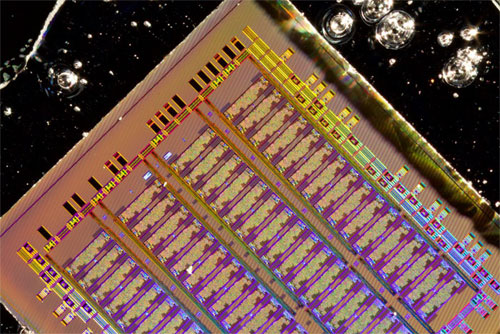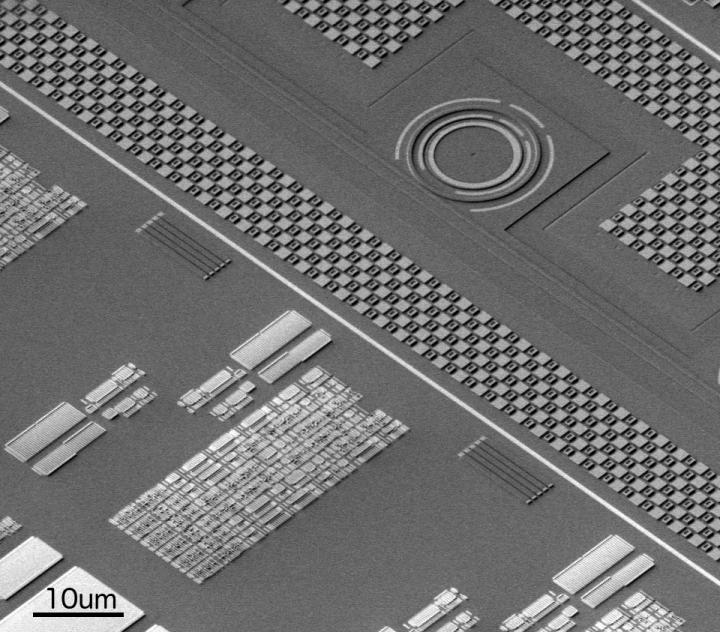BROOKLINE, Mass., April 26, 2018 — A new platform and fabrication method has been developed for making silicon chips that can communicate with photons. The technology, which is no more expensive than current chip technology, could alleviate bottlenecks in current devices by speeding data transfer and reducing energy consumption by orders of magnitude.
Most silicon nanotechnologies rely on bulk silicon substrates, which are limited in their ability to integrate with photonic functions. The research team, which included scientists from Boston University (BU), the Massachusetts Institute of Technology (MIT), and the University of California Berkeley, introduced photonics into bulk silicon CMOS chips using a layer of polycrystalline silicon deposited on silicon oxide (glass) islands fabricated alongside transistors.

The bulk silicon electronic-photonic chip designed by the MIT, UC Berkeley and Boston University team. Courtesy of Amir Atabaki.
The team integrated this photonic platform with a 65-nm-transistor bulk CMOS process technology inside a 300-mm-diameter-wafer microelectronics foundry. Integrated high-speed optical transceivers were then implemented into the platform. The transceivers, which operate at 10 Gbps, are composed of millions of transistors. They are arrayed on a single optical bus for wavelength division multiplexing, to address the demand for high-bandwidth optical interconnects in data centers and high-performance computing.
By decoupling the formation of photonic devices from that of transistors, the research team was able to achieve many of the goals of multichip solutions but with the performance, complexity, and scalability of “systems on a chip.” By introducing a set of new material layers in the photonic processing portion of the silicon chip, optical communication was enabled with no negative impact on the electronics.
The team worked with semiconductor manufacturing researchers at the SUNY Polytechnic Institute in Albany, N.Y., to develop its manufacturing solution to ensure that any process that it developed could be seamlessly inserted into current industry-level manufacturing.

Three-dimensional electron microscope image of a region of the MIT-UC Berkeley-BU electronic photonic chip, showing a photonic ring resonator (top right), alongside an electronic circuit block (bottom left). Courtesy of CNSE Albany.
Researchers used the new platform to realize optical waveguides and resonators, high-speed optical modulators, and sensitive avalanche photodetectors.
The new platform promises faster and more energy-efficient communication, which could improve the performance of computing and mobile devices.
“By carefully investigating and optimizing the properties of the additional material layers for photonic devices, we managed to demonstrate state-of-the-art system-level performance in terms of bandwidth density and energy consumption while starting from a much less expensive process compared to competing technologies,” MIT researcher Fabio Pavanello said.
“Instead of a single wire carrying 10 to 100 Gbps, you can have a single optical fiber carrying 10 to 20 terabits per second — so about a thousand times more in the same footprint,” BU professor Milos Popovic said.
The team believes that its manufacturing solution could be applicable to even the most commercially widespread chips based on bulk silicon.
“If you replace a wire with an optical fiber, there are two ways you win. First, with light, you can send data at much higher frequencies without significant the loss of energy there is with copper wiring," Popovic said. "Second, with optics, you can use many different colors of light in one fiber, and each one can carry a data channel. The fibers can also be packed more closely together than copper wires can without crosstalk.”
Applications using the new technology, beyond traditional data communication, could include accelerating the training of deep-learning artificial neural networks used in image and speech recognition tasks, low-cost IR lidar sensors for self-driving cars, smartphone face identification, and augmented reality technology. In addition, optically enabled microchips could enable new types of data security and hardware authentication, more powerful chips for mobile devices operating on 5G wireless networks, and components for quantum information processing and computing.
“For the most advanced current state-of-the-art and future semiconductor manufacturing technologies with electronic transistor dimensions below 20 nm, there is no other way to integrate photonics than this approach," professor Vladimir Stojanovic of UC Berkeley said. "All of the material layers used to form transistors become too thin to support photonics, so the additional layers are needed."
Popovic, Stojanovic, and MIT professor Rajeev Ram have formed a startup company, Ayar Labs Inc., which has partnered with GlobalFoundries to commercialize the technology.
The several-years-long project was funded by DARPA.
The research was published in Nature (doi:10.1038/s41586-018-0028-z).